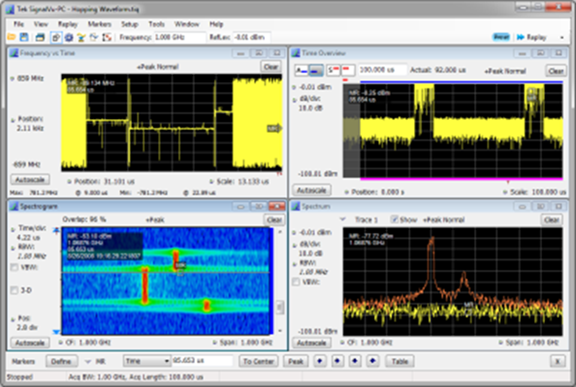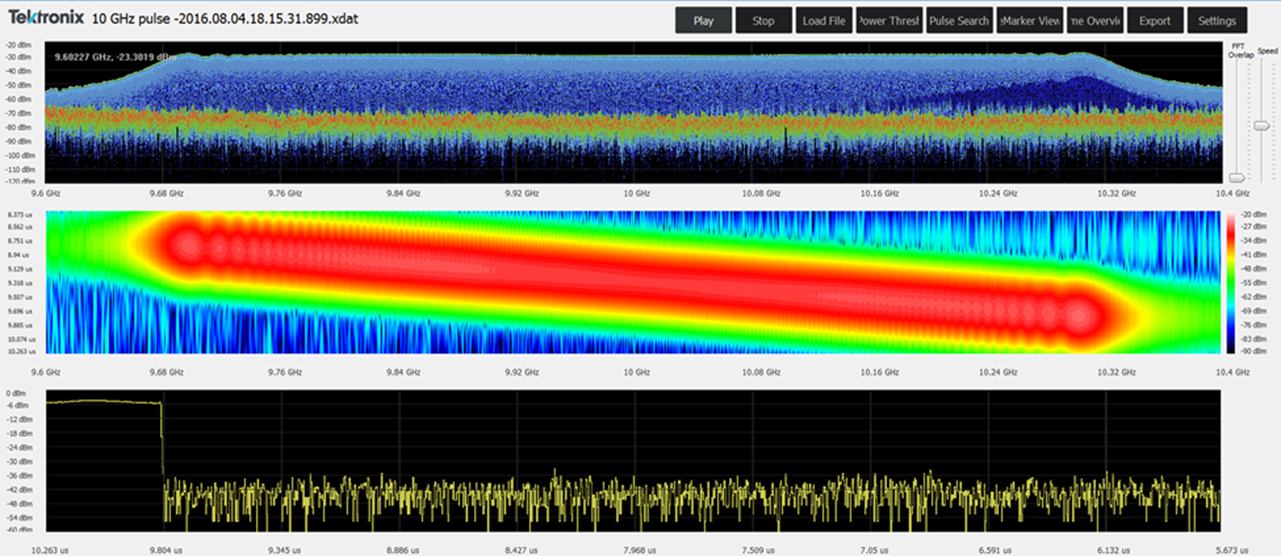
Today’s Real-Time Spectrum Analyzers include features and capabilities that go far beyond the basic measurement capabilities of conventional spectrum analyzers. Among these capabilities is the ability to capture and record RF data vs. time for playback and analysis. So, what is RF Capture and Playback? It turns out, the answer is multi-faceted. There are several different ways that today’s real-time analyzers can capture and record RF signals. The captured data can be played back in a number of different ways. Let’s examine the various aspects of RF Capture and Playback.
DPX Spectrum Recording
The DPX display is the real-time spectrum display. It shows the composite result of millions of spectrum measurements per second in a color graded bitmap display, where the different colors represent the density of spectral activity. The DPX display includes an option to enable a DPXogram function.

The DPXogram is a waterfall-type display that accumulates spectrum traces in a scrolling strip-chart fashion. The spectrum traces recorded in the DPXogram are composed of traces computed from the DPX spectrum results , using a Max Hold function employed during the time interval between the DPXogram traces. The DPXogram can record up to 60,000 spectrum traces. The user can set the time between traces, thus giving control over how much actual time is recorded across the set of 60,000 spectrum traces, which can span from minutes to days in time.
The time-stamped DPXogram traces can be saved to disk, and can be replayed to review the seamless recorded spectral history. DPXograms are supported on the RSA300/500/600 series of USB analyzers, as well as the RSA5100/6100/7100 series of benchtop analyzers and the SignalVu-PC software.
RF Acquisition and Analysis / Replay
This is the heart of the spectrum and vector signal analysis of a real-time spectrum analyzer. The RF signal is converted to baseband IQ data which is acquired seamlessly, often based on a trigger, into analysis memory.

Once acquired, the data can be analyzed in multiple domains simultaneously (frequency, time, modulation domains) while maintaining time correlation between them. Display and measurement parameters can be changed, and various measurement displays can be added or removed, and then the acquired data can be Replayed to show new/revised results.
These acquisitions can range from a few microseconds to several seconds or more, depending on settings and hardware used. This type of capture, analysis and replay is supported by all of the real-time spectrum analyzers, as well as offline analysis with SignalVu-PC software.
Streaming RF Recording and Playback
The RSA300/500/600 series of USB analyzers offer streaming RF recording capability over the USB3 port. RF signals over a 40MHz bandwidth at the analyzer’s center frequency can be seamlessly streamed to disk in the host PC. A solid state hard drive is required to perform the streaming in order to keep up with the high speed writing rate – approximately 13GB per minute. The RF analysis streaming can be performed simultaneously with other analysis displays up and running.

Once a recording is complete, it can be played back through SignalVu-PC. During playback, SignalVu-PC behaves as if the signal was being captured on an RSA, with a few minor exceptions such as being unable the change the center frequency.
Analysis of large recorded files can also be performed with DataVu-PC, which provides the ability to view spectrums vs. time, amplitude vs. time, as well as being able to perform signal searches, pulse analysis and the ability to select time segments of interest for export to SignalVu-PC for deeper signal analysis.
Streaming Wideband IQ Recording & Analysis / Playback
The benchtop RSA5100/6100/7100 series Real-Time Spectrum Analyzers offer the ability to stream IQ data directly to disk for long-term seamless recording. The RSA5100/6100 series support streaming at bandwidths up to 165/110MHz via a pair of parallel LVDS ports on the instrument interfaced to an external RAID recording system.

The RSA7100 series can stream up to 320/800MHz bandwidth to a built-in RAID system. The RAID recording systems can record 10s of terabytes of IQ data, which can represent hours of seamless wideband RF recording. RF streaming can be performed simultaneously with real-time spectrum and signal analysis. The recorded data files can be played back, examined and analyzed using DataVu-PC as described above. This tool can be used to help identify time segments of interest for deeper analysis with SignalVu-PC.